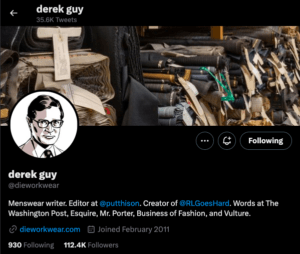If you’ve spent just a few minutes on your “For You” feed on Twitter in the past few weeks, you must have run into some tweets by the user commonly referred to as “menswear dude” or “menswear guy.”
You know who I’m talking about – @dieworkwear, whose username is Derek Guy, shares insights about the history of menswear and practical tips about how to wear a suit and other garments in more or less lengthy Twitter threads, and somehow, these tweets are everywhere.
Although many people are wondering why Twitter keeps trying to make them follow Guy and some are even (wrongly) angry at him, there’s a lesson to be found in his sudden success.
If you’ve been trying to figure out how to work with Twitter’s algorithm and boost your follower count and engagement, Guy might be the guy for you!
Keep reading to find out more about Twitter’s recent changes, how Derek Guy shows that blue checkmarks have lost some of their significance and Twitter threads are more powerful than ever, learn more about the various types of threads he writes, and the key elements of a good thread.
What is happening with Twitter?
Ever since Elon Musk acquired Twitter, things have been a little unstable on the platform. Certain features have disappeared only to suddenly resurface in brand new versions, such as the live audio feature Twitter Spaces, while monetization of the platform has become more of a reality with Twitter Blue, allowing people to purchase a verified blue tick.
These changes, which are probably part of a trial-and-error strategy for Musk to find out what works best for his revised version of the platform, have altered the way Twitter operates.
Since January 10 2023, users logging into the platform are presented with their “For You” feed by default.
This feed, unlike the regular “Following” feed, offers an enhanced experience, showing you not only tweets from the people you follow but also the ones that your network interacts with and, more generally, very popular tweets that are doing the rounds on the platform at large.
Little by little, people have started to notice this change in the algorithm as it puts different kinds of tweets to the foreground and offers exposure to new kinds of accounts – not only verified or more “official” ones.
While the “For You” partly explains why users like Derek Guy suddenly get a lot of exposure, these users’ own behaviors also need to be looked at. After all, they must have done something right first for the algorithm to even notice them!
The example of @dieworkwear can illuminate the current best practices for growing on Twitter.
Blue checks don’t mean much anymore
The “For You” feed and the boosting power it’s had for certain accounts has made one thing extremely clear: the blue tick is no longer the sign of success it once was!
Derek Guy’s follower count was around 25,000 until last November, and as of late January 2023, it’s reached 112.3k – which isn’t nearly as much as plenty of other users, and he still doesn’t have a blue check next to his name.
This goes to show that your level of relevance is no longer measured by the same numbers, in particular follower count.
In fact, the old checkmarks – referred to as “legacy checkmarks” and which people didn’t pay for but gained through popularity on the platform or celebrity status in the offline world – will be retired in a few months according to Musk himself.
These signs of popularity and legacy are now deemed obsolete and instead, someone like Derek Guy can be favored by the algorithm for his content only and grow organically, without the help of a verified status to sanctify his value.
Threads work!
Whether or not you are passionate about menswear, you may find it interesting to read about how much a button-up shirt should cost in just a few informed tweets. After all, we all wear shirts and have to buy them and may wonder how those numbers on the price tag are decided!
I said earlier that the wide availability of cheap clothing has made people lose touch with the cost of making clothes given fair wages. So let's talk about how much a button-up shirt should cost. 🧵 pic.twitter.com/hvxnnB94js
— derek guy (@dieworkwear) January 22, 2023
Plus, so much of Twitter is meaningless, uninteresting and unfunny content that doesn’t resonate with us. Rants and impersonal tweets just don’t add anything to your life!
By contrast, it can be very refreshing to stumble upon a thread that catches our attention and doesn’t make us regret scrolling on Twitter for a few or many minutes.
Derek Guy’s threads are of different types and often even combine many aspects that make a Twitter thread succesful.
Educational threads
Although we know little about Derek Guy, he clearly is an expert in his field and has said in interviews that he first started writing online by running a Tumblr blog about menswear. His threads seem effortlessly knowledgeable and nuanced, the mark of someone who really knows what he’s talking about, and he clearly takes genuine pleasure in educating his audience.
Threads allow him to fulfil his mission to teach people that clothing is a language and to encourage them to explore it as such.
As part of this mission, he doesn’t hesitate to debunk myths and explore more complex and potentially problematic topics, which makes his feed all the more intriguing and unique.
For instance, his thread on the Western aesthetic at once acknowledges the general opinion on the matter – namely that it is problematic since it is tied to America’s colonialist and murderous past – and offers a more balanced and informed view, explaining that storytelling and movies have also informed the way we perceive the Western look as symbolic of strength, individualism and resilience.
It’s a great history lesson in just a few tweets!
There are gross elements in every historical aesthetic. Suits can be reduced to the rise of the Second British Empire. Ivy style is associated with privileges derived from inherited wealth. But when you dig deeper into these aesthetics, their histories are more complicated 🧵 https://t.co/QJI3l3O6N1
— derek guy (@dieworkwear) January 27, 2023
Practical advice
Not only can scrolling Twitter occasionally add to your general knowledge, but it can also give you practical tips!
In addition to writing about the history of fashion, Guy writes Twitter threads about how best to choose your tailoring or how to shrink a huge second hand sweater as well. His expertise allows him to offer practical advice that you may not find elsewhere, or at least not in such a compact, readable format.
HOW TO SHRINK A GIANT SWEATER 🧵
Thinking about the time a friend of mine bought a giant, vintage sweater for like $10, threw it into the wash, and then it fit perfectly. Knowing stuff like this can make you a better thrifter. pic.twitter.com/2OthzRffqU
— derek guy (@dieworkwear) January 25, 2023
Such threads can really boost your account because not only do they make you appear knowledgeable, but they also make you seem useful to your followers: you offer concrete value in just a few words!
Story thread
@dieworkwear keeps his privacy, but that doesn’t mean he doesn’t occasionally lift the envelope a little on his life. He sometimes shares personal fashion stories, which in addition to building the mystique around who he is, also make evident his genuine passion for clothes and how much they mean to him.
This level of sincerity is particularly refreshing on Twitter, where vacuous content and promotional tweets are the norm.
Moreover, storytelling done well is engaging. A follower can read your first tweet in the thread and get hooked to keep reading. If a story really resonates, the user may feel compelled to share it with his friends and followers, giving you more exposure.
In his thread about the Western look, Guy goes personal and shares a story about an old friend and a token of their friendship that ties in with the topic he explores.
Key elements of an engaging Twitter thread
The form of @dieworkwear’s threads is as crucial to their success as their content. Not only does he share useful, interesting and engaging content, he also delivers it with a certain style and using Twitter’s features intelligently to generate the most interest. Here’s a breakdown of some aspects of formatting to keep in mind when crafting your Twitter threads:
Use visuals
what you what you
think you actually
look like look like pic.twitter.com/H9ODPMc6zF— derek guy (@dieworkwear) January 27, 2023
Since Guy discusses fashion, it makes sense that he usually adds pictures to his tweets, but whatever topic you’re addressing, you can benefit from doing the same. Photos, videos or even GIFs make your content more playful and enjoyable to watch, and can compliment your words.
You can even follow Guy’s example and occasionally tweet out memes that still deliver your piece of information but do so in a more fun way!
Sense of humor
30% of online menswear content is just guys being like "can you ID this white shirt?" pretty sure you're not attracted to the shirt bro pic.twitter.com/5CwAvbWYBK
— derek guy (@dieworkwear) January 24, 2023
Although delivering useful tips on Twitter can make for an attentive audience, if you come off as too lecturing or condescending, you risk losing followers who aren’t there to listen to the niche knowledge of an arrogant expert!
Guy has clearly been online for years and handles internet talk with a gusto, wit and a looseness that makes even his most detailed and serious content fun and never dry. This shows that he doesn’t take himself too seriously, even as his passion for menswear runs deep!
Personality and point of view
the plan? start a custom tailoring company and convince jordan peterson to wear a series of 12 increasingly ridiculous outfits pic.twitter.com/UQu1phUNTd
— derek guy (@dieworkwear) January 10, 2023
In his interviews, Guy has talked about how sudden fame has made him a little more careful about what clothing brand he makes fun off because he’s not interested in shaming anyone. However, he remains opinionated (in a playful way) and doesn’t mind antagonizing one side of the discourse to be true to himself.
His repeated puns about Jordan Peterson and his suits won’t please everyone, but he has a lot of fun crafting them and his audience appreciate his angle. The way to build an audience isn’t to try and cast as wide a net as possible, but instead to know who you are and stick to your own principles.
Although where Twitter is headed remains unclear, the example of @dieworkwear reveals how important Twitter threads are today and what personality and genuine passion can do for your Twitter growth and engagement, so get out there and give people some of your knowledge!





